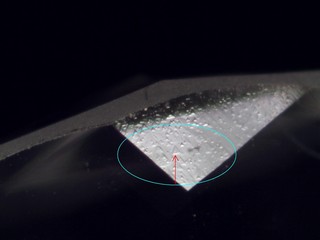A Trigon is a unique feature found in some natural diamonds that is characterised by its triangular shape, often appearing as fine, concentric triangular lines or marks. These trigon patterns are typically seen on the surface of the diamond, and they form due to the natural growth and crystal structure of the diamond during its formation deep within the Earth.
Trigons are particularly important in the field of diamond identification and diamond grading, as their presence can serve as a definitive indicator that a diamond is natural, distinguishing it from synthetic or man-made diamonds. These markings are not commonly found on diamonds that have been synthetically produced in a laboratory environment, making them a key feature for gemologists when verifying the authenticity of a diamond.
Formation of Trigons
Trigons are formed as part of the natural crystallisation process of a diamond. They arise from the growth patterns within the diamond’s crystal lattice. As the diamond forms under extreme heat and pressure deep within the Earth, the atoms in the crystal align in a very specific way, leading to the appearance of these fine triangular lines on the surface of the diamond.
The exact appearance and positioning of the trigons can vary depending on the specific growth conditions and the orientation of the diamond’s crystal structure. While the trigons themselves may be very fine and microscopic, they are typically visible under magnification using tools like a jeweller’s loupe or microscope.
Identification of Natural Diamonds
Trigons are a strong indicator that a diamond is natural, as they are rarely, if ever, seen in synthetic diamonds. The formation of these fine triangular lines is a direct result of the natural growth process of diamonds, and their presence can be considered one of the tell-tale features used by gemologists to confirm a diamond’s authenticity.
When a diamond is subjected to high magnification, these trigons are typically seen as small, triangular grooves or lines that radiate from the centre of the facet, resembling a fan-like or concentric pattern. They are often most visible on the pavilion facets of the diamond, though they can occasionally be found on the crown facets as well.
Trigon Markings and Natural Diamond Identification
Because trigons are exclusive to natural diamonds, they play a vital role in the gemological analysis of diamonds. Advanced testing and examination techniques, such as microscopic examination or spectroscopic analysis, can reveal these markings, providing a clear distinction between natural and synthetic diamonds.
Furthermore, Trigons are particularly significant for diamond authentication. In addition to other characteristics, such as inclusions or crystal formation patterns, trigons offer a way for gemologists to trace a diamond’s origin and determine whether it has been subject to artificial creation processes.
Importance in the Diamond Market
While trigons are a natural feature, their presence can sometimes add to the uniqueness of a diamond, particularly in the context of natural diamond collections and antique jewellery. For collectors or buyers of natural diamonds, the presence of trigons may enhance the perceived value, as it adds a layer of authenticity and rarity to the gemstone.
In addition, these natural growth features can be a useful tool for diamond appraisers and gemologists who are tasked with identifying and grading diamonds. Trigons help confirm that the diamond has not been altered, treated, or synthetically produced, ensuring that it maintains its full natural value.
Trigons are triangular, concentric marks found in natural diamonds, created by the crystal growth process deep within the Earth. These fine markings are a definitive indicator of a diamond’s natural origin and are used by gemologists and appraisers to authenticate diamonds. Trigons are an important feature in distinguishing natural diamonds from synthetic diamonds, and their presence contributes to the unique nature of a natural diamond.
